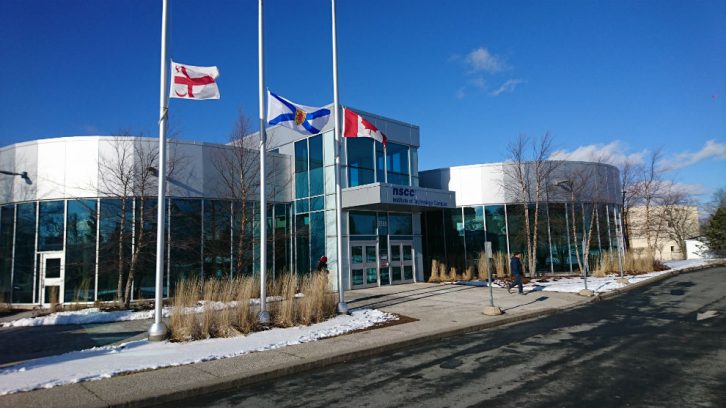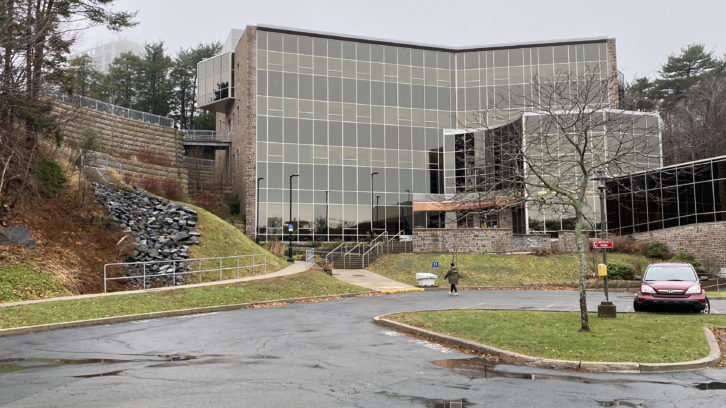What Halifax universities are doing to reduce carbon emissions — and what they’re not
Nova Scotia's post-secondary institutions not yet legally required to cut carbon

caption
A passerby crosses in front of Dalhousie University's Killam Memorial Library Thursday.In the absence of government regulations, Halifax universities are approaching the problem of climate change with varying degrees of urgency.
A year after Nova Scotia’s government pledged to make the province carbon neutral by 2050, the Signal has asked HRM’s four major post-secondary institutions what they are doing to reduce emissions from their campuses.
October 2019’s Sustainable Development Goals Act mandated that lawmakers pass a more specific emissions reduction plan by the end of this year, but introduced no new regulations. Post-secondary institutions say they are voluntarily cutting greenhouse gas emissions from their HRM campuses, but the scale of their changes is inconsistent.
Public consultations for the eventual new regulations mandated by the act have been delayed until 2021 because of COVID-19.
In the meantime, Nova Scotia Environment spokesperson Barbara MacLean said in an email that, “Nova Scotia does not have legislation that mandates universities to reduce their GHG (greenhouse gas) emissions.” The result is that any interventions are at the discretion of administrators and vary significantly between schools.
Ecology Action Centre (EAC) energy coordinator Ben Grieder recommended in an interview that campuses looking to become more sustainable start with a comprehensive climate plan. The EAC advocates for sustainable government policy and environmentally friendly economic development.
Grieder listed three key questions: “The main thing that needs to be looked at is, how is energy being used on campus? How is the energy being distributed on campus? And ultimately, how is that energy being produced?”
The Signal contacted Dalhousie University, Saint Mary’s University, Mount Saint Vincent University and Nova Scotia Community College for more information about how they plan to go green.
Dalhousie University
Dalhousie University published its Climate Change Operations Plan in 2019, following up on an older, 2010 document. The 26-page document is the only one of its kind provided to the Signal by a Halifax institution, making Dalhousie the only school that has followed Grieder’s main recommendation.
The operations plan, which mirrors the Sustainable Development Goals Act’s target of net-zero emissions by 2050, pledges a revamp of nearly every aspect of how Dalhousie powers its campus. All three of Grieder’s key areas of concern — energy production, distribution and consumption — are addressed.
Justin MacDonald, Dalhousie’s on-site energy manager, said a key achievement for Dalhousie in the past decade has been cutting its use of carbon-intensive fuel oil and bunker fuel by over 90 per cent each. Previously, the two petroleum products provided most of the energy for the university’s heating systems.

caption
Dalhousie’s Central Services Building on Henry Street houses the central heating plant for its Halifax facilities, as well as its Office of Sustainability.The bunker fuel and fuel oil have almost completely been replaced by natural gas, which burns cleaner but is a major source of methane pollution during its extraction process. “It’s definitely, by far, not at all what I would recommend as a fuel source for university campuses,” said Grieder.
But MacDonald said Dalhousie is exploring more sustainable gas sources, such as biofuels, and hopes to eventually invest in off-campus renewable energy projects that could yield carbon credits.
On the energy distribution front, old boilers that produced steam to be piped between buildings for heat have been replaced with a more efficient hot water heating system.
And energy consumption is being cut with the help of green building upgrades, like better insulation, windows that conduct less heat and more efficient climate control systems.
Grieder commended Dalhousie for having a climate plan with clearly defined goals and strategies, and said the university’s strategy to go carbon-neutral via industrial-scale renewable energy project was promising.
“They’ve done some interesting things,” he said. “Considering off-site renewables, it’s a good idea. It’s a way to offset their energy through some kind of generation. It’s an indirect way, but it could work.”
Saint Mary’s University
Cale Loney, a spokesperson for Saint Mary’s University, said in an email that the institution is in the midst of a “carbon reduction project” that will see improvements to the campus’s energy efficiency. But SMU lacks a unified policy of the type Grieder recommends.
Instead, Loney said the university’s concern for the environment informs all of its infrastructure and policy decisions.
SMU has relied primarily on natural gas to power its heating systems since 2007, which it says has reduced direct emissions from its campus by about a third. Publicly documents do not specify whether a transition to cleaner forms of gas is on the horizon.

caption
Pedestrians cross in front of Saint Mary’s McNally building, which dates back to 1952, on Thursday.Also like Dalhousie, SMU is moving to replace its inefficient steam heating system with a less energy-intensive hot water system, which will require less fuel to operate.
“They’re going from older, more expensive fuel — which is dirty and has aging infrastructure that costs a lot to fix and maintain — and replacing it with natural gas, which is cost-effective. The same could be said of the steam,” said Grieder commenting on the changes.
“But my question would be, if they don’t have a plan, then any time anyone considers renovating a building, is there even a question of reducing greenhouse gas emissions, or is it just about doing the most cost-effective thing?”
Nova Scotia Community College
A decade ago, Nova Scotia Community College carried out a major energy-efficiency retrofit of its aging IT campus — one of the college’s three Halifax locations. The renovations marked the beginning of an institution-wide revamp of NSCC’s energy production and consumption.
Kirk Herman, NSCC’s environmental engineer, said in an interview that the upgrades have included better insulation, energy-efficient lighting and sometimes upgraded walls and roofs. The changes have reduced direct emissions from NSCC campuses by about a third.

caption
Like Dalhousie and Saint Mary’s, NSCC burns natural gas for heat in many of its buildings. But the Ivany Campus on Dartmouth’s waterfront is heated using steam from nearby Dartmouth General Hospital, along with geothermal heating.
NSCC is also participating in Nova Scotia’s Solar Electricity for Community Buildings pilot program, which sees it generate renewable energy that it sells back to the power grid.
The college’s annual sustainability report includes a rating from the Philadelphia-based Association for the Advancement of Sustainability in Higher Education. For 2019-2020, NSCC ranked ninth overall in Canada, but claimed the top spot for a college and beat out Dalhousie, which ranked 12th.
“This is something that the college is really focused on,” said Herman.
NSCC’s does not yet have a single, unified climate plan. But its sustainability policy includes a pledge to create one, as well as a requirement that decision-makers adhere to the tenants of the Sustainable Development Goals Act.
Grieder said he suspects the college is waiting on more concrete guidance from the province via the follow-up legislation mandated by the act.
“The approach they’re taking makes sense,” he said. “My only worry there is that, if there’s another delay (in passing provincial climate legislation per the Sustainable Development Goals Act), is NSCC going to wait another year before creating a plan?”
But he added that he approves of the college’s choice to employ a range of different emissions reductions strategies, rather than attempting to find a one universal solution.
“What I like is that they’re exploring the different possibilities, like the steam from the hospital,” said Grieder. “It seems like they’re considering, not just what works on one building… but trying different technologies and seeing what works the best. I think they’re taking the right approach.”
Mount Saint Vincent University
According to Mount Saint Vincent University spokesperson Gillian Batten, an ongoing facilities improvement program that began in 2011 and is now undergoing a revamp focuses heavily on improvements to buildings’ energy efficiency, including upgraded windows, lighting and climate control systems.
Batten said the efficiency improvements, along with a switch to natural gas for heating, has reduced fossil fuel consumption by an amount roughly equivalent to about 70 three-bedroom homes annually.

caption
A woman enters Mount Saint Vincent’s Margaret Norrie McCain Centre, which was built in 2015, on Thursday.She added that electricity consumption has been cut by the equivalent of about 80 homes annually, or about 960,000 kilowatt hours — down from just under 6 million kilowatt hours in 2011.
The Mount is also looking to hire an energy engineer, to help with future efficiency upgrades.
But although the university has issued an environmental policy statement pledging to reduce emissions, it has not published a climate plan.
“It sounds like they’re taking the right steps in the right direction. But again, it seems like it’s more from a cost-effective standpoint,” said Grieder. “Have they figured out what their impact to the environment is right now and what they can do to reduce that impact? They seem to know how much electricity and fuel they’re using… But I don’t know that a full picture there has really been revealed.”

